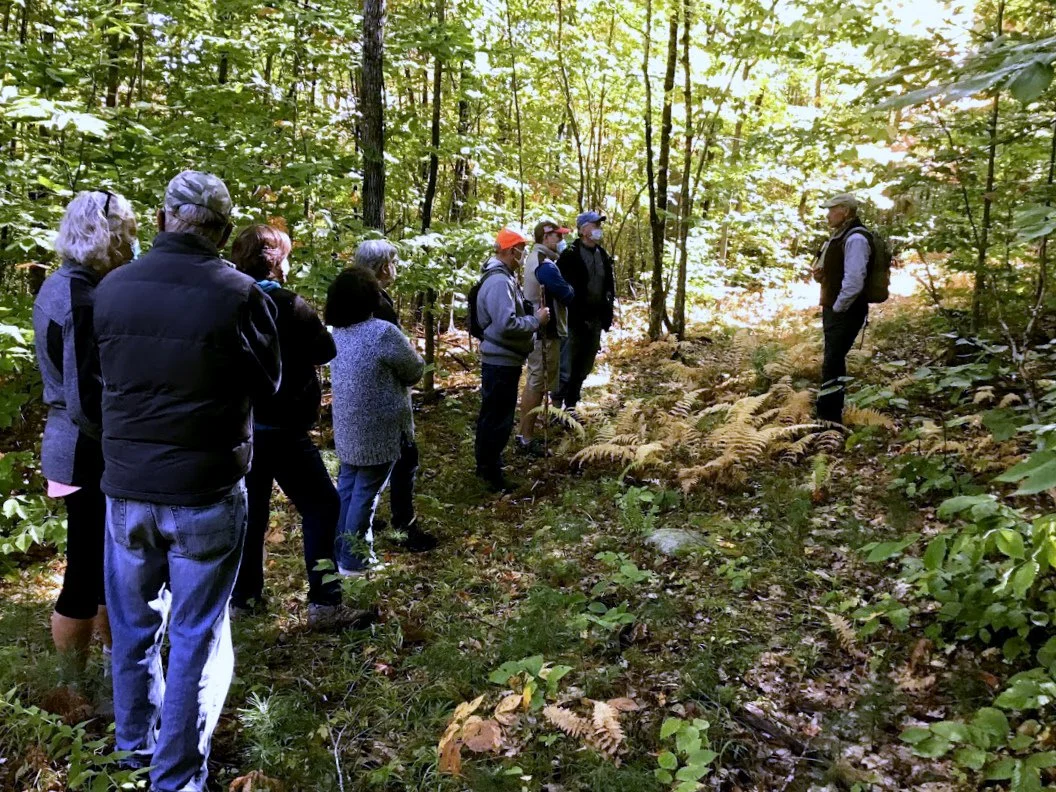A Walk in the Woods: Preserving and Protecting Our Forests
Earlier this month, a small but enthusiastic group of forestry fans joined experienced forester Daniel Stepanauskas for a hike through the woods to learn about the delicate yet vital balance of healthy forests with sustainable human use and management. With over 40 years of experience under his belt with the US Forest
Service, the Kennett Company, the Forest Stewardship Council, and others, Dan was the perfect guide and conversation catalyst. As the group walked through the woods, he led a thoughtful conversation around forest use, climate change, and human-led management.

The climate crisis causes widespread harm to natural resources - forests are no exception. Dan was able to point out specific instances of the effects of climate change to New Hampshire’s forests. For instance, white pine numbers in the state are declining from a devastating increase in fungi infections and needle drop due to higher moisture levels over time. Our state tree, the beloved paper birch, is especially vulnerable to climate change’s effects and is struggling due to more drastic freeze and thaw cycles in winter months. Dan pointed out that our best chance to preserve our state’s beautiful wooded landscape is to maintain well-stocked forests with plenty of diverse tree species.
While vulnerable, forests are also one of our best lines of defense against climate change. The group learned about carbon sequestration, a photosynthetic process that all trees use to store carbon in their trunks, leaves, and roots. Carbon sequestration reduces the amount of carbon that escapes into our atmosphere by trapping carbon in biomass and soil. It's an important process for reducing the greenhouse gas effect. While all trees do this, Dan highlighted the particular need for tree species that store high levels of carbon - often those with dense wood and large trunks. Pine, oak, and black walnut trees are a few great candidates.
Participants learned that human use of forest products does not have to be at odds with our goal of protecting forests, however. Sustainable management and harvest techniques are vital. One practice that Dan recommended is that, after cutting trees, it is best to leave the nutrient-dense treetops behind so that their nutrients will return to the soil and feed new growth. This technique also enriches the soil with organic matter through decay, while feeding insects, rodents, and other wildlife all the way through the food chain. Another practice is to exercise caution when thinning forests, making selective cuts -- sudden sun exposure or stress can increase Epicormic sprouts, also known as “suckers” or “water sprouts” (your plants at home, like lilacs, may also suffer from suckers!) These solutions offer a win-win to humans as well, as the value of a harvestable tree only increases with time and careful pruning.
MMRG would like to thank Dan for sharing his time and wisdom with the group. As one of the most-densely forested states in the country, it is vital for New Hampshire to maintain a healthy and diverse forest stock for both wildlife and human enjoyment. All of us can follow good stewardship practices to keep our wild and wooded forests thriving for centuries to come.
Interested in learning more about forests? Join MMRG and Branch Hill Farm for our next free workshop, Exploring Forest Habitats, on October 31st from 10am-1pm! Charlie Moreno (NH Licensed Professional Forester) and Mariko Yamasaki (Research Wildlife Biologist, USDA Forest Service) will guide us through two very different forest habitats in Milton, NH — a mature forest with century-old hemlock and pine, and a six-years-young forest patch containing new growth. Participants will learn about the essential value that these habitats offer to the invertebrates, birds, and mammals that call them home. We’ll also discuss habitat ecology, maintaining optimal ecological areas, and long-term management strategies. Registration is required and space is limited -- more information here!

